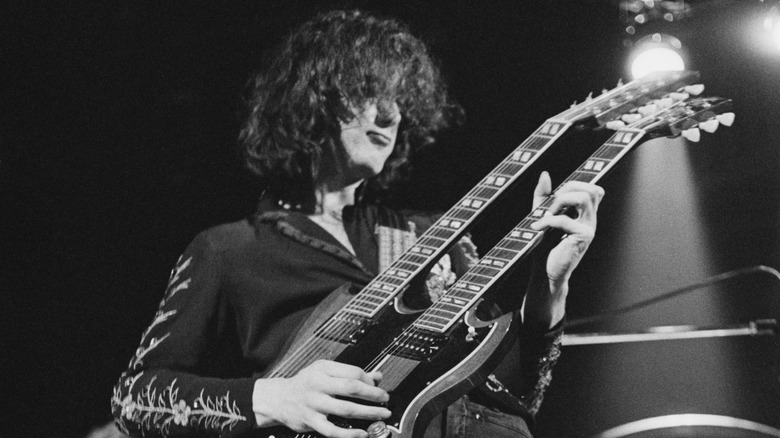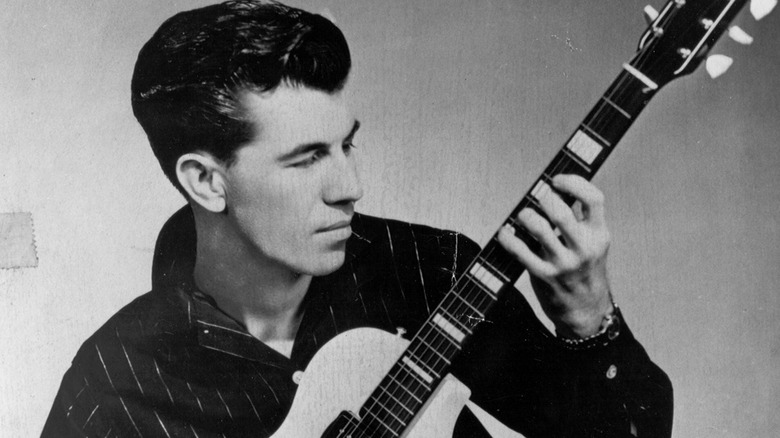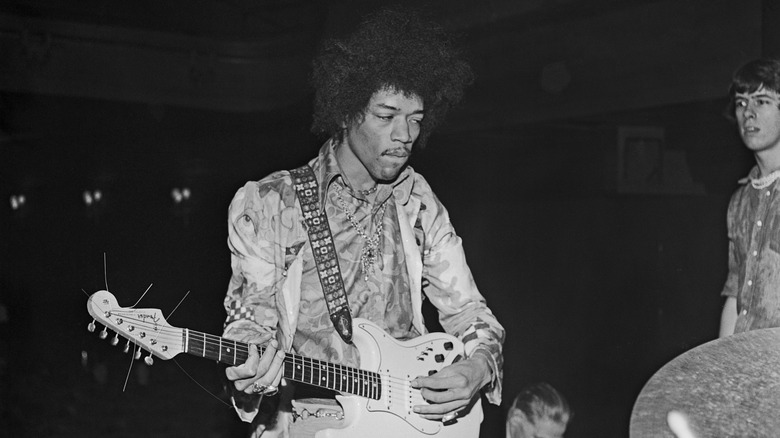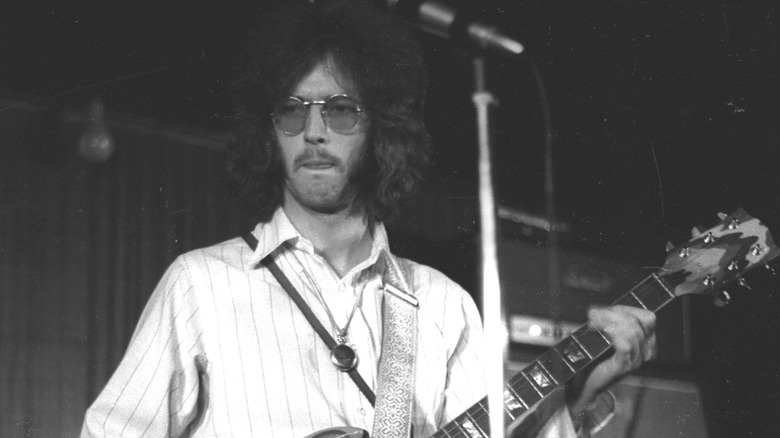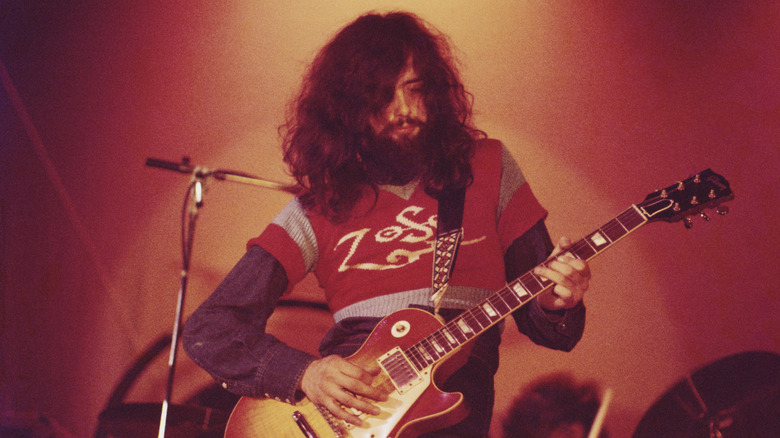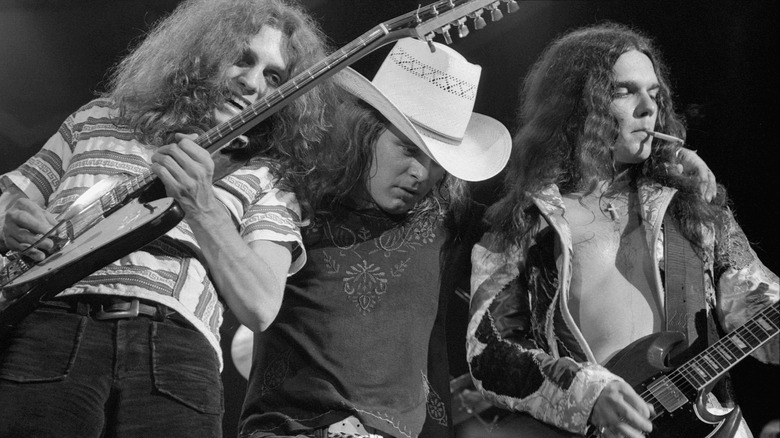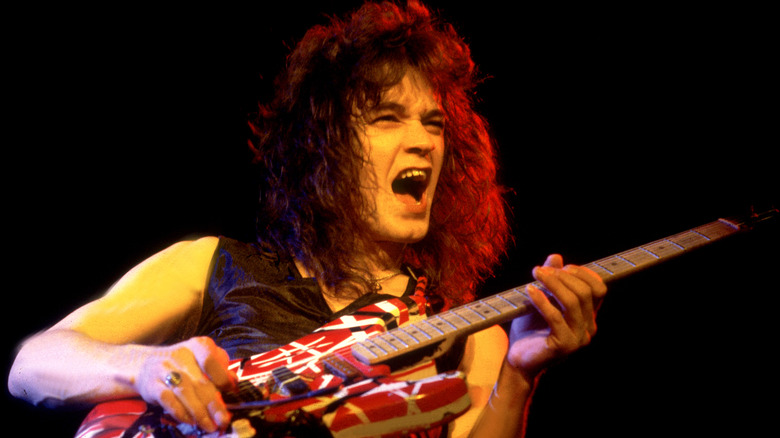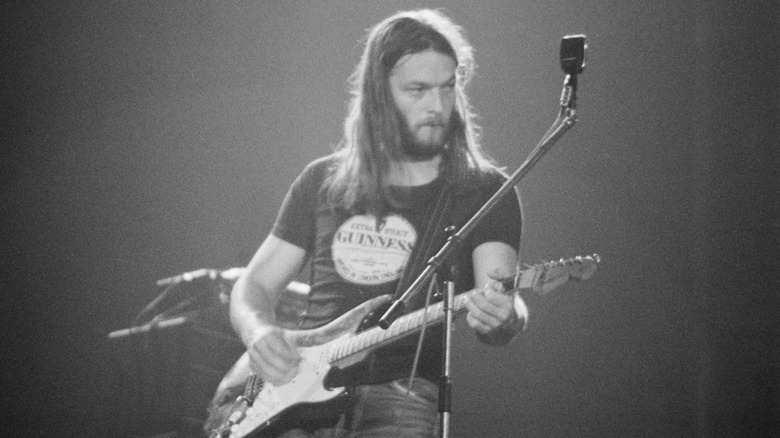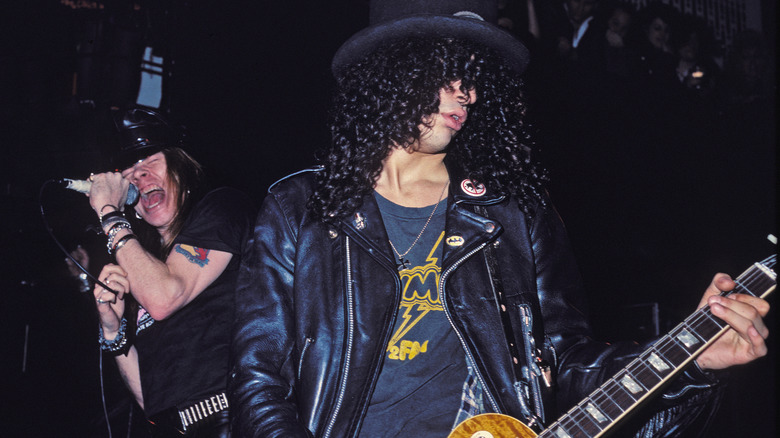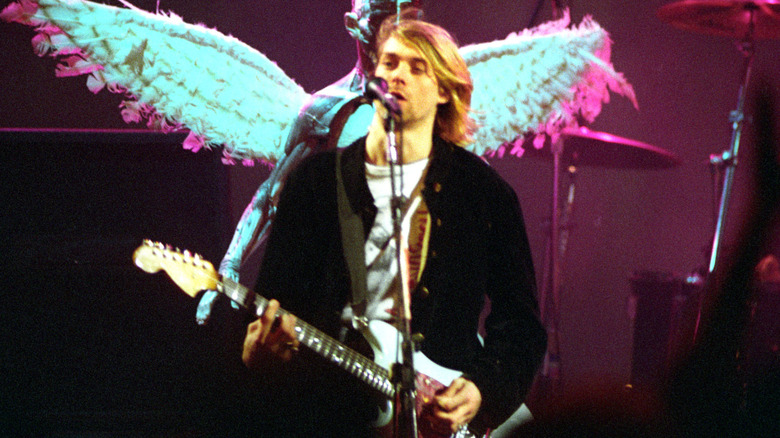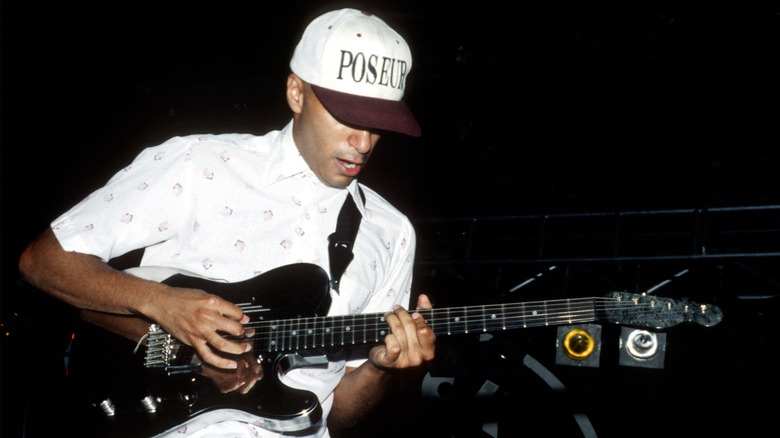Guitar Solos That Changed Rock Music Forever
Since its genesis in the early to mid-'50s, rock music has evolved numerous times, occasionally waxing and waning in popularity but remaining a key part of many a zeitgeist in its various forms. As most fans will tell you, the guitar solo is one of rock's most defining features — there were times when playing them felt dated and stale (the late '90s/early '00s nu-metal scene immediately comes to mind), but it always found its way back to relevance within the genre. And why not — the history of rock music has seen so many great guitar players come and go, and these musicians continue to inspire up-and-coming players regardless of the era's prevailing musical trends.
What follows is a chronologically arranged list of guitar solos that became so iconic that they changed the game in the broader rock scene in one way or another. They may not always be the best solos in a technical sense, but they either proved to be especially influential to future generations of musicians or emblematic of the era in which they were recorded — or both.
Rumble (Link Wray)
Out of all the songs that left moral guardians in a tizzy back in rock 'n' roll's early days in the 1950s, one of the most threatening tunes didn't even have any lyrics. Performed by Link Wray and the Wraymen, the 1958 single "Rumble" is best known for its power chords — dark, intimidating riffs that, along with its title, conjured images of violence and gang fights. This was mostly thanks to some primitive distortion, which Wray achieved by poking holes into his amplifier's speaker after an onstage mishap accidentally jacked up his guitar's volume during one show. Take note that this all happened six to seven years before songs like the Kinks' "You Really Got Me" and the Rolling Stones' "Satisfaction" brought distorted guitar sounds to the mainstream.
While the main riff gets most of the attention, "Rumble" also contains a furious lead guitar break in the middle — it's barely a solo, but it certainly adds to the menacing feel of the song, which proved influential to many a budding musician — and future rock legend. The Who's Pete Townshend credited "Rumble" for inspiring him to start playing guitar, while Bob Dylan referred to it as the "finest instrumental ever," even opening several shows with the song not long after Wray's death in 2005 (via Far Out Magazine).
Hey Joe (Jimi Hendrix)
Although the song's origins are widely disputed, there's no doubt that Jimi Hendrix's version of "Hey Joe" is the most popular. A number of groups covered the tune in the mid-'60s, including the Byrds and Love, as well as the much lesser-known Leaves, whose version peaked at No. 31 on the Billboard charts in July 1966. But while all those bands opted for a fast-paced delivery, Hendrix stayed truer to the song's folk ballad roots, taking inspiration from Tim Rose's slower version and incorporating bluesy solos that gave his version much more gravitas than the faster ones that came before it.
Of course, Hendrix would go on to craft numerous jaw-dropping solos in his short yet brilliant career. However, his solos on "Hey Joe" are especially significant, as he was reportedly playing this song when Animals bassist Chas Chandler discovered him performing at a New York club. Chandler was so impressed by the young, virtually unknown guitarist that he became his manager, convincing him to take his talents to the U.K., where "Hey Joe" went all the way to No. 6 on the country's pop charts. Unfortunately, the song failed to chart back home in the U.S., but it remains one of the most beloved songs in Hendrix's discography to this day.
While My Guitar Gently Weeps (The Beatles with Eric Clapton)
It's quite the ironic twist that the man responsible for what could be the best guitar solo on a Beatles song wasn't even one of the Fab Four. As requested by George Harrison during sessions for the band's self-titled "White Album" in 1968, his good friend Eric Clapton contributed the solo on "While My Guitar Gently Weeps," and he delivered on the song's title and then some, infusing his guitar playing with the same sad emotiveness of Harrison's lyrics. It was also quite beneficial to the rest of the Beatles, as Harrison recalled how Clapton's presence in the studio made his bandmates take the recording sessions more seriously.
While Clapton's solo easily made "While My Guitar Gently Weeps" a fan favorite and one of the standout tracks on the "White Album," it has continued to resonate in far more modern times. In 2004, on the same night he was inducted into the Rock and Roll Hall of Fame, Prince astounded fans during an all-star performance that also included Tom Petty, Jeff Lynne, Steve Winwood, and Harrison's son Dhani, adding his own touches to the solo on "While My Guitar Gently Weeps" while staying faithful to the original version. It was arguably better than Clapton's version, and it was, as it turned out, an act of revenge of sorts for Prince getting left out of Rolling Stone's list of the 100 greatest guitarists. He didn't need to drop any salty comments — all he did was personalize one of the greatest guitar solos of all time to underscore what was a major oversight on the publication's part.
Stairway to Heaven (Led Zeppelin)
Led Zeppelin's signature song, "Stairway to Heaven" has been a fixture of pop culture since it appeared on the band's fourth album in 1971. Its popularity is such that many guitar stores have unwritten rules banning customers from playing the song – or written rules, as hilariously depicted in the 1992 movie "Wayne's World." Then there's the whole backward-masking controversy, where some overly imaginative individuals have accused Led Zeppelin of devil worship through the track's purported message when played in reverse. But you can't deny that Jimmy Page played one heck of a guitar solo, transforming "Stairway" from a mellow, mystical folk-rock ballad to a pulsating hard rocker in its final minutes.
Speaking to The Guardian in 2014, Page admitted that this was all part of the plan: He wanted to create a tune that went against rigid songwriting conventions where one doesn't abruptly switch tempo or stray too far from the standard verse-chorus-verse format. "The thing I was very keen to establish was that the whole thing would keep moving in tempo and intensity," Page said. "The tempo changes from the beginning to the end -– it's quite radically different -– but that was the intention."
Granted, "Stairway to Heaven" was not the only multi-sectional rock epic of the early '70s. But it's a fair point to say that "Stairway" walked so that the likes of Queen's "Bohemian Rhapsody" could run, further establishing the importance of the song and its iconic solo in rock history.
Free Bird (Lynyrd Skynyrd)
In its initial iteration, Lynyrd Skynyrd's "Free Bird" was a mere four minutes long, a mournful ballad with very few bells and whistles. Axemen Gary Rossington and Allen Collins soon added a guitar outro, but in those early days of the would-be classic's existence, that solo lasted just about a minute long. That would change during one gig where front man Ronnie Van Zant asked the guitarists to extend the solo so he could rest his voice.
"[O]ne night we were playing a club and Ronnie said: 'Play that a little longer, my voice is hurting, I need a break," Rossington told Classic Rock. So we played two minutes or three minutes. Then two days later his throat was all sore and he could hardly talk, and we ended up playing it 10 minutes at the end, just jamming."
The finished product that ended up on the band's 1973 debut album, "Pronounced Leh-Nerd Skin-Nerd," wasn't that much shorter, clocking in at 9 minutes and 7 seconds. As such, hardly anybody — not even Skynyrd themselves — expected the song to do well on the pop charts. But that's exactly what it did, peaking at No. 19 on the Billboard Hot 100 in early 1975 and serving as an early example of a commercially successful track with dueling lead guitar parts ... and an unusually long runtime.
Eruption (Van Halen)
Jimmy Page paved the way for two-handed tapping with his solo on Led Zeppelin's "Heartbreaker," but he was using only one hand while pulling off this already impressive technique. Eddie Van Halen, however, perfected it on "Eruption," taking inspiration from the "Heartbreaker" solo and using both hands to come up with a style of playing that many, particularly those in the 1980s Sunset Strip hair metal scene, sought to imitate but couldn't quite replicate.
Before "Eruption" became the instrumental lead-off track on Van Halen's self-titled 1978 debut record, it was just a warm-up exercise. But when producer Ted Templeman overheard Eddie playing it in the studio, he was so impressed that he asked engineer Donn Landee to hit the record button ASAP. "I was in this little room making phone calls next to the recording studio, and I walked in and Ed was sitting there kind of playing it," Templeman said in an interview with Guitar Player. "And I went, 'What's that?' and he said, 'It's just something I warm up with before each show.' And I said, 'Donn, roll tape!' and he said, 'I'm rolling.'"
For his part, Eddie Van Halen, who died on October 6, 2020, admitted to Guitar World that the version of "Eruption" that made the album didn't turn out as well as he had hoped. "I didn't even play it right," he said. "There's a mistake at the top end of it. Whenever I hear it, I always think, Man, I could have played that better." He really didn't have to, as despite its supposed imperfection, "Eruption" continues to inspire bedroom guitarists many decades later.
Comfortably Numb (Pink Floyd)
Not only is "Comfortably Numb" one of Pink Floyd's best-known songs. It may also contain David Gilmour's best guitar solo as a member of the legendary psychedelic rock act, one defined not by speed or volume but rather by the raw emotion that matches the 1979 track's lyrical despair. While most other guitar heroes of the era tried to cram as many notes as possible into one solo, Gilmour favored a "less is more" approach, and it worked perfectly. Gilmour set the bar very high for guitarists hoping to add a similar exclamation point to the closing minutes of their slower, more dramatic tracks.
Most fans may know the real story behind "Comfortably Numb" — it was inspired by a concert where front man Roger Waters was given a powerful muscle relaxant that seriously inhibited his ability to perform. But it also drove a wedge between Waters and Gilmour, who have been feuding for the better part of the last five decades. Speaking to MOJO (via pink-floyd.org), Gilmour described songs like "Comfortably Numb" as the "last embers of Roger and [I's] ability to work collaboratively together — my music, his words." Meanwhile, Waters told Musician magazine in 1992 that Gilmour's second version of the song's closing solo was boring, and that both men had to compromise by combining parts from both versions for the finished track. "[I]t was just awful ... it was stilted and stiff, and it lost all the passion and life the original had," Waters said of the second version.
Sweet Child o' Mine (Guns N' Roses)
Compared to the vast majority of their Sunset Strip peers, Guns N' Roses was infinitely darker and more dangerous. Save for their earliest days, they eschewed the big-hair-and-makeup ethos of 1980s hair metal, focusing instead on the realities of their hardscrabble lives and a lot of other stuff that didn't age well. (We're looking at you, "One in a Million.") But they were also known to play sensitive rock ballads, including their first and only No. 1 single, 1988's "Sweet Child O' Mine." Though probably best known for its repetitive yet catchy main riff, it also features a solo from Slash that's just as soulful as it's gritty. By combining these two qualities, he set himself apart from — and ahead of — most hard rock and metal guitarists of the era and beyond.
Looking back on "Sweet Child" many years later, Slash told Total Guitar (via Music Radar) that he wasn't a fan for some time because, as a faster-paced ballad, it felt off-brand for Guns N' Roses. But he remains proud of his solo, which he singled out as his favorite part of the song because of how naturally it came to him. "That was a very organic solo that came together simply," Slash explained. "When we said, 'Here's the chord changes,' it occurred very spontaneously, and I always looked forward to that part of the song in the set. It was completely different to the rest of the song."
Smells Like Teen Spirit (Nirvana)
Sometimes you don't need to be a virtuoso on guitar to come up with a game-changing solo. Case in point? Nirvana, which burst onto the mainstream with the release of their 1991 album "Nevermind" and its carrier single, "Smells Like Teen Spirit." Singer-guitarist Kurt Cobain didn't have to get especially creative when writing the song's guitar solo; all he did was parrot its verse and pre-chorus vocal melodies in a classic anti-rock star move that was right up the alley of the burgeoning Seattle grunge movement.
With the rise of Nirvana and grunge, the era of hair metal and its guitar gods was over. Cobain was all about angsty lyrics and back-to-basics riffs and licks, rather than songs about rock 'n' roll decadence and fleet-fingered solos (usually) in the middle of such tunes.
In an interview with Rolling Stone, Cobain further exemplified the "oh well, whatever, never mind" message of his band's signature song by commenting on his super-simple lead guitar part. "I don't even remember the guitar solo on 'Teen Spirit,' he said. "It would take me five minutes to sit in the catering room and learn the solo. But I'm not interested in that kind of stuff. I don't know if that's so lazy that I don't care anymore or what. I still like playing "Teen Spirit," but it's almost an embarrassment to play it."
Killing in the Name (Rage Against the Machine)
While there had been quite a few rap-metal or rap-rock crossovers in the years that preceded their rise to fame, Rage Against the Machine perfected the formula, and it was thanks in large part to Tom Morello's guitar work. Serving as a perfect complement to front man Zack de la Rocha and his politically charged lyrics, Morello essentially transformed his guitar into another instrument, making it almost sound like a turntable when he wasn't chugging out percussive, hip-hop-flavored riffs.
Morello's unique talent as a guitarist was on full display in 1992's "Killing in the Name," which evolved from typical heavy metal licks on the demo version to something that sounded similar to what you'd hear on a hip-hop record. "I was trying to approximate Dr. Dre's production or Cypress Hill or the Bomb Squad, Terminator X stuff," he told Spin in 2012. "And that provided the high-pitch wailing of some of that music. So I know I went hog-wild on a number of songs, one of them being 'Killing in the Name.'"
All told, "Killing in the Name" is the perfect introduction to the Rage Against the Machine experience. It's also a reminder that while they influenced many a rap-metal hybrid in the years that followed, their seamless fusion of those genres was just that revolutionary — no pun intended — and hard to replicate.
